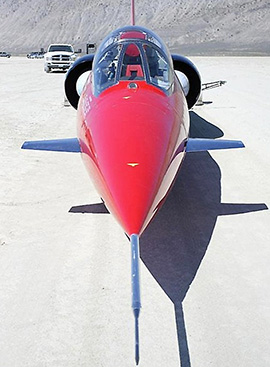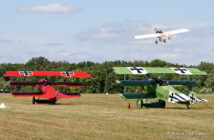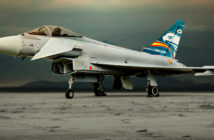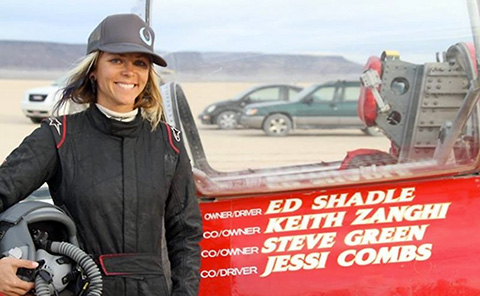
US female driver Jessi Combs posing in front of the unique North American Eagle racer before her speed record on 9 October 2013. ©NAE official
Dashing on Oregon’s 20 km Alvord Desert dried out lake bed, US TV star Jessi Combs at the helm of the North American Eagle Supersonic Speed Challenger managed to reach a top speed of nearly 600 km/h (597 km/h) on her first racing pass, while on the second, performed just one hour later, using the Eagle’s afterburner to full effect, she hit a speed of 709.25 km/h, giving out a record breaking average speed of 632.39 km/h: a new world record on land for a female driver.
The North American Eagle is no ordinary racing car. It is a converted Mach 2 capable Lockheed F-104 Starfighter that once actually served as a USAF chase plane for both the record breaking North American X-15 experimental jet and the Mach 5 Lockheed SR-71 Blackbird spy plane. This racing car is something that its designer, the famous engineer Clarence ‘Kelly’ Johnson would certainly never have imagined!
Retaining its original lateral intake air ducts but sporting smaller wings to retain speed stability, the slick red sNAE racer weighs in about 6 tons (5,896 kg) and measures 17.07 m from nose to tail and just over 2.1 m across at the widest point on the engine intakes. Propelled by a General Electric LM-1500 axial-flow turbojet engine (military designation J79), the NAE crew increased the engine’s stock output by 10,000 hp from the leisurely 42,000 hp used for low speed test runs, up to the current 52,000 hp. But with great power comes great mileage degradation as the car is a super gas-guzzler!
North American Eagle reports the jet’s appetite for fuel at idle to be in the 40 gallons/minute (151 l/min) range, but when under full throttle the Eagle vaporizes out 80 gallons/minute (302.8 l/min). Kick in the afterburner and another 10 gallons (37.8 l) disappears out the Eagle’s oversized, military grade tailpipe every minute. The Eagle’s afterburner does provide the pilot a short burst of instant power, essentially doubling output from an already impressive 52,000 hp.
As the Paris-based Federation International de l’Automobile (FIA) is the governing body for land speed records, strict rules regarding engines and wheel configurations had to be followed in order to properly qualify. The FIA rules require the vehicle to be considered a “car” sporting four wheels. So in order for the Eagle to blast across at the lake bed at subsonic speeds, solid billet aluminum wheels were chosen. These solid aluminum wheels not only reduce rolling weight but remove traditional concerns regarding centrifugal forces associated with rubber tyres. The solid wheel system also allows the driver to focus on “piloting” the ground based fighter rather than having to literally drive it.
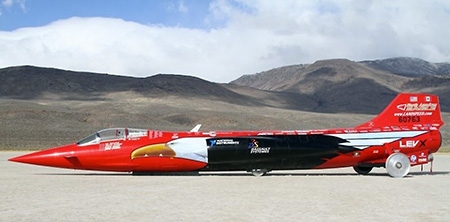
The North American Eagle on the Oregon horizontally flat dried-lake bed. The vehicle has two in line aluminum road wheels in front and a pair of larger stabilizing wheels at the rear. Among the sponsors of the new world record breaking racing contraption is Dassault Systèmes of France. ©NAE official
The Eagle’s cockpit, like on most racing cars, is spartan in order to save weight. Instrumentation is limited to engine temperature gauges, fuel and oil pressure gauges and the all important air speed indicator and mach meter. The steering wheel is a joystick, providing tail and rudder control at speeds similar to its airborne Starfighter counterpart. Unlike traditional fighter jets where oxygen is supplied to the pilot, the NAE team went with a simpler system using a scuba diving tank to provide compressed air.
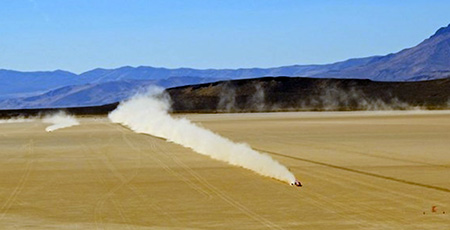
The North American Eagle dashing on the Alvord Desert lake bed on 9 October 2013 at some 600 km/h. ©NAE official
The NAE crew hopes to break the existing land speed record of 1,225 km/h in the Eagle next year, this time with team owner Ed Shadle at the stick. In the meantime, Jessi Combs next plans to chase down the existing female speed record of 824 km/h achieved in 1976 by US stunt woman Kitty O’Neil in a three-wheeled racer.

